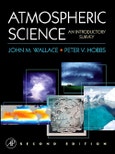Atmospheric Science, Second Edition, is the long-awaited update of the classic atmospheric science text, which helped define the field nearly 30 years ago and has served as the cornerstone for most university curricula. Now students and professionals alike can use this updated classic to understand atmospheric phenomena in the context of the latest discoveries, and prepare themselves for more advanced study and real-life problem solving.
This latest edition of Atmospheric Science, has been revamped in terms of content and appearance. It contains new chapters on atmospheric chemistry, the Earth system, the atmospheric boundary layer, and climate, as well as enhanced treatment of atmospheric dynamics, radiative transfer, severe storms, and global warming. The authors illustrate concepts with full-color, state-of-the-art imagery and cover a vast amount of new information in the field. Extensive numerical and qualitative exercises help students apply basic physical principles to atmospheric problems. There are also biographical footnotes summarizing the work of key scientists, along with a student companion website that hosts climate data; answers to quantitative exercises; full solutions to selected exercises; skew-T log p chart; related links, appendices; and more. The instructor website features: instructor's guide; solutions to quantitative exercises; electronic figures from the book; plus supplementary images for use in classroom presentations.
Meteorology students at both advanced undergraduate and graduate levels will find this book extremely useful.
Please Note: This is an On Demand product, delivery may take up to 11 working days after payment has been received.
Table of Contents
1. Introduction and Overview2. The Earth System
3. Atmospheric Thermodynamics
4. Radiative Transfer
5. Atmospheric Chemistry
6. Cloud Microphysics
7. Atmospheric Dynamics
8. Weather Systems
9. The Atmospheric Boundary Layer
10. Climate Dynamics








